By Lisa Bailey
With involvement at the local, provincial and national level of epilepsy agencies, Paul Raymond has gained new perspective on the realities and challenges for people living with the seizure disorder.
 Now, as Epilepsy Ontario’s new executive director, he’s energized by the prospect of helping to change the landscape and enhance the lives of people throughout the province.
Now, as Epilepsy Ontario’s new executive director, he’s energized by the prospect of helping to change the landscape and enhance the lives of people throughout the province.
“It (Epilepsy Ontario) is a great organization, this is a great opportunity,” he says. “And I came from an agency of Epilepsy Ontario so it’s nice to be able to move on to new challenges.
“I loved the local agency role, the hands-on (aspect of it), but I’m really excited about some of the larger-scale issues especially around advocacy and effecting provincial change.”
For instance, Raymond says, Epilepsy Ontario is engaged with a number of provincial ministries on various issues, such as enhancing care for people living with epilepsy and educating teachers to lessen fear and boost preparation around a possible seizure incident at school.
“There are issues where we’re really trying to make changes so we can improve the quality of life of people living with epilepsy across the entire province,” Raymond says.
His past roles and experiences have generated a solid education and understanding of many advocacy issues. Raymond was Epilepsy York Region’s executive director for the past eight years. Before that, he had been Epilepsy Ontario’s fund development director and Epilepsy Canada’s communication director.
“Each level has given me a very different perspective,” Raymond says.
His work at the national level gave him a sense of the differences across the country. With Epilepsy York Region, he provided front-line services to people living with epilepsy and learned about the challenges they face.
“With every step closer to the community, I gained a much better understanding from that face-to-face connection with people living with epilepsy,” Raymond says. “They were coming into my office and I was meeting them. And that’s what I think really prepared me for the role at the provincial office – it’s having that front-line contact with what the real issues are.”
Those issues range from medication side effects and public transportation access to the negative perception of people who live with epilepsy, and the paralyzing fear of having a seizure in public. These issues can cascade and lead to depression and isolation.
“The fear of having a seizure in public is so great that (people living with epilepsy) choose not to go out and not to contribute to society – not to seek employment or not to volunteer because the issue is just overwhelming to them.”
Hearing these stories first-hand has given Raymond a real personal perspective on issues that he can then share with elected officials and public servants.
“To relay the individual stories of people living with epilepsy is absolutely critical,” he says, expressing hope that it will heighten understanding and awareness of what are complicated challenges so they can then be addressed.
Raymond says he’s come to Epilepsy Ontario at a good time; he commends his predecessor, Rozalyn Werner-Arcé, and the board of directors for defining in recent years a clear role for the organization and growing its credibility as a “go-thru” agency connecting people with local support partners and agencies.
He hopes to enhance those connections even more with his strengths in communication and team building.
“I really see Epilepsy Ontario working with all of the agencies in Ontario as a cohesive group . . . I think my contribution would be bringing the agencies and the provincial level together and working together to make all of Ontario a better place for people living with epilepsy.”
If you have a story to share or feedback on this article, please contact the newsroom at 800-294-0051, ext. 25, or e-mail lisa(at)axiomnews.com.






